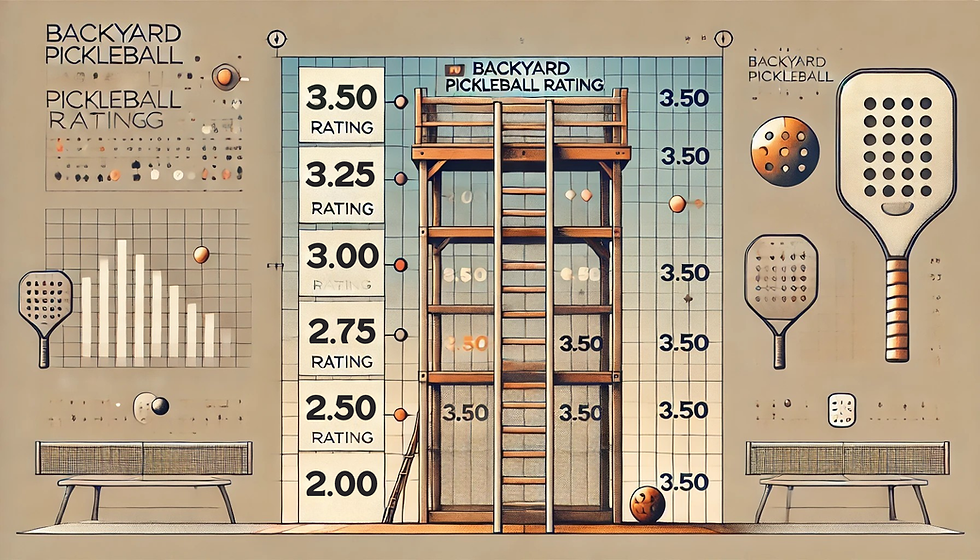Introducing the Backyard Pickleball Rating (BPR)
- Sunny Day

- Jan 31
- 4 min read
Updated: Jan 31

A New Way to Measure Pickleball Performance – The Backyard Pickleball Rating (BPR)
What is BPR?
The Backyard Pickleball Rating (BPR (pronounced "beeper")) is a dynamic rating system designed to provide a more accurate reflection of player skill and performance in our league. Instead of simply ranking players based on win percentage, BPR evaluates multiple factors to ensure fair and meaningful rankings.
Think of BPR as our league’s superior version of DUPR (Dynamic Universal Pickleball Rating). While DUPR is used to rate players across tournaments and clubs worldwide, BPR is tailored specifically for our Backyard Pickleball League and considers the unique structure of our competitive ladder format.
Why is BPR Replacing Win Percentage?
In a ladder league, players compete against others at similar skill levels, meaning win percentage alone can be misleading. A player who consistently competes against top-ranked opponents and goes 3-3 (50%) should likely be rated higher than someone who dominates weaker competition with a 6-0 (100%) record.
BPR eliminates this imbalance by factoring in who you play against, how well you perform, and the difficulty of your matches to ensure rankings reflect true skill.
What Goes Into the BPR Calculation?
BPR is influenced by a combination of the following factors:
Wins and Losses: Your match outcomes still matter! Winning helps, but the quality of your wins is just as important.
Strength of Opponents (SoS): Defeating strong opponents boosts your rating more than beating weaker ones.
Strength of Partners: If you win while paired with a lower-rated partner, it can increase your rating more than winning with a strong partner.
Points Won Percentage: This measures the percentage of total points won in all matches played. A higher PW% generally indicates stronger play on both offense and defense. While winning close games still helps, BPR rewards players with a larger PW% since it shows consistent performance in scoring and preventing points. Players who dominate their matches with a strong point margin will typically have a higher BPR than those who barely edge out their opponents.
Surprise Factor: Exceeding expectations (e.g., upsets against higher-rated teams) positively impacts your rating.
Retroactive Adjustments – The BPR Evolves
One unique aspect of the BPR system is that it is retroactive. This means past matches are recalculated each week based on updated player ratings.
For example, if you previously defeated a player rated 3.00, but that player later improves to 3.25, your past victory becomes more valuable, and your rating could increase retroactively. This ensures ratings continuously reflect the latest skill levels.
Understanding the BPR Scale
The BPR scale ranges from 2.00 to 3.50, with 2.75 being the starting point for all players. For a league built on mediocrity, there's simply no need for a scale to go beyond 3.50. A rating of 3.50 represents a top-tier player in our league, while a rating closer to 2.00 indicates a developing player.
What This Means for the League
By implementing BPR, our standings will now be based on a more comprehensive and fair rating system rather than a simple win-loss record. This ensures that playing tougher competition is rewarded, and the best overall players rise to the top.
Are you a nerd that want to get in the weeds about this new rating? Check out The Technical Breakdown of the Backyard Pickleball Rating Algorithm for a deeper look into the equations behind the BPR!
FAQ: Common Questions About the BPR System
Why did my rating go down even though I won games?
BPR doesn’t just look at wins—it considers who you played and how you performed. If you won matches against lower-rated opponents but didn’t dominate, your rating might not increase (or could even drop). Conversely, narrow losses against stronger players might improve your rating.
I used to have more underdog wins. Why has that changed?
Since BPR updates past matches retroactively, your "Underdog Wins" may change if your previous opponents have moved up or down in rating. If a player you beat later drops in rating, that win is no longer considered an upset.
What happens if I don’t play for a while?
Unlike traditional rating systems where a lack of play freezes your rating, BPR is retroactive and adjusts past results based on new opponent ratings.
If players you previously defeated increase their BPR, your past wins become more valuable, possibly increasing your rating even if you haven’t played recently.
Conversely, if past opponents struggle, your rating could drop due to those previous wins becoming less meaningful.
However, because BPR also accounts for strength of opponents, players who stop playing may fall behind those who continue to compete and improve.
How can I improve my BPR the fastest?
Win against higher-rated opponents.
Have a high points-won percentage.
Perform consistently over time.
Play frequently – more matches = more opportunities to improve.
Is there a maximum or minimum BPR?
Yes, BPR ranges from 2.00 to 3.50. No one can exceed 3.50, and no player will drop below 2.00.
How often is BPR updated?
BPR is updated after each league session, ensuring that the latest matches influence the rankings.


Comments